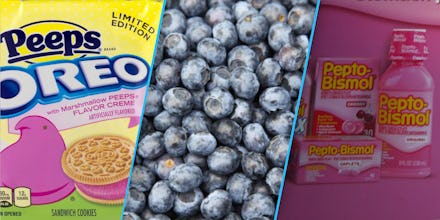Here's why Peeps Oreos — and other foods — turn your poop all different colors

Peeps Oreos are pink
In March, people daring enough to try the new Peeps Oreos found out that the novel cookie sandwiches turned their stool bright pink.
What's behind the magical color change?
Food dye is the culprit, BuzzFeed reported. "The OREO PEEPS limited-edition sandwich cookies contain a bright pink food coloring, FD&C Red no. 3," an Oreo spokesperson told BuzzFeed, reporter Julia Reinstein tweeted.
Here's why Peeps Oreos make your poop pink
When it comes to fecal matter, you are what you eat. Your body rids itself of unwanted waste and your diet can influence whether your caca is chocolatey brown or has tints of green or red.
Food dyes like Red no. 3 pass through the digestive tract, but so do natural colors from fruits and vegetables, BuzzFeed noted. Your body doesn't use artificial colors, so they'll pass right on through your body to the toilet bowl.
"Artificial coloring is not broken down by the human body," Anish Sheth, a doctor specializing in gastroenterology and co-author of the book What's Your Poo Telling You, said in an email to Mic. Sheth said that if you eat large quantities of artificial colors, they'll "manifest" in your stool.
But even if you don't subsist on a diet full of food dyes, you might see your fecal matter change colors. "Insoluble fiber is not digested, so things like corn, beets [and] spinach can lend color to stool," Sheth said.
"Everything we eat is first broken down in the stomach by acid and pepsin, then in the small intestine by bile and digestive enzymes," Sheth said. "The sum of these processes leads to changes between how something looks when it goes in versus when it comes out."
Wondering what else has the power to change the color of your poo? Here's an non-exhaustive list of foods that create notoriously colorful feces.
Burger King's Halloween Whopper
The Halloween Whopper had consumers in for a scary surprise: It allegedly turned bowel movements bright green.
The blue and yellow food dyes used for the bun probably weren't absorbed from the intestines and thus combined to turn stools green, LiveScience noted. Moral of the story: The color of the food doesn't always correspond to the color of your excrement — it's all about the dyes within.
Blue Slurpees
Blue slurpees and other artificially blue drinks often contain the food dye Blue no. 1, according to BuzzFeed. But don't expect to see blue in your toilet bowl — the dye will, in fact, turn your turds green, not blue.
Pepto-Bismol
Pepto-Bismol may not be a food, but ingesting the medicine can change your stool to a deep black color. The active ingredient bismuth calms inflammation in the gut but also impacts the color of your waste, VeryWell reported.
Beets
The magenta veggie will give your doo-doos a red hue, as will other red foods like tomato juice or soup, VeryWell reported. But beet lovers, beware: Red stool could also be from blood due to hemorrhoids. If your stool is consistently red, your best bet is to get in touch with your health care provider.
Blueberries
These antioxidant-packed berries are considered a true superfood, but they're also super in one special way. Ding ding! That's right, they can change the color of your stool.
The skin of blueberries is an insoluble fiber, "which is why if you eat enough blueberries, your stool turns a dark color," Sheth said. It can even turn your stool black, VeryWell reported.
Sweet potatoes
Orange you glad you ate sweet potatoes last night? You might be saying that to yourself if you're staring down at an orange-colored floater. Since sweet potatoes and yams are high in beta-carotene, eating them may tint your poops, according to VeryWell.
Kale and other leafy greens
Oh kale yeah. If you eat a lot of this green leafy vegetable, there's a chance your poop will turn slightly green. The green comes from chlorophyll, the chemical that helps plants convert sunlight into energy, Healthline reported. Who knew overdosing on vegetables could have such colorful consequences?